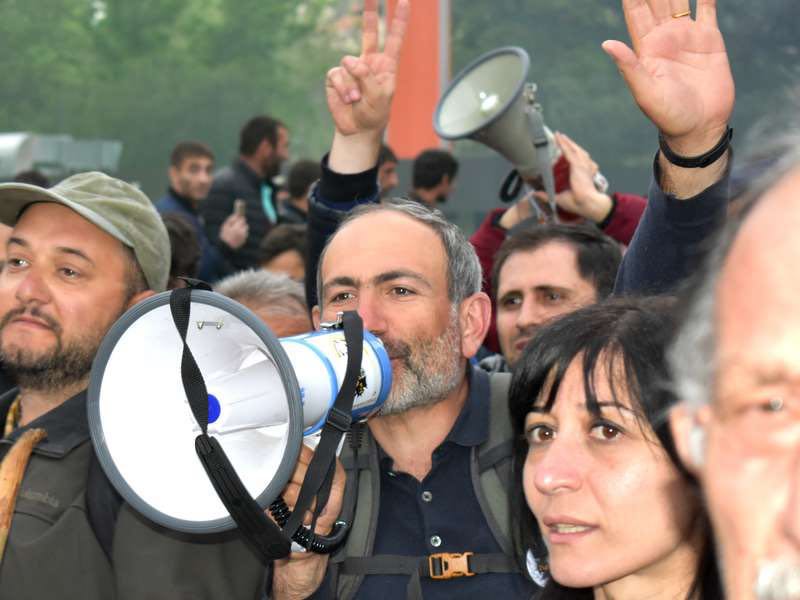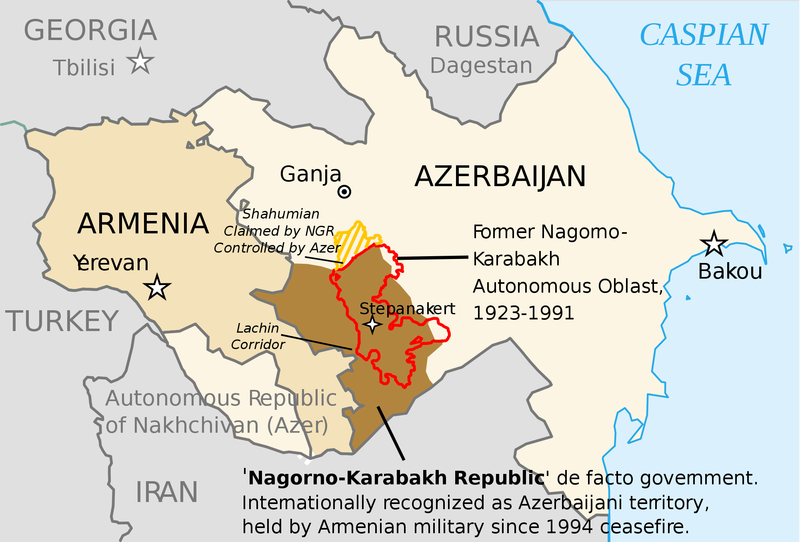Russia's president Putin was among the first foreign leaders to congratulate Nikol Pashinian after becoming Armenia's prime minister as a result of the popular uprising. Putin expressed the expectation that 'friendly, allied relations' will be further strengthened. Pashinian is careful not to upset the Kremlin. Behind the peaceful change of the ruling class in Armenia, however, there is the unsolved Karabakh conflict and its international repercussions, says Caucasus-expert Thomas de Waal.
by Thomas de Waal
The Armenian crisis has had many observers of the post-Soviet space scratching their heads. According to conventional analysis, a ruling regime is not supposed to capitulate so easily to street protests. Moreover, Moscow is supposed to get upset when a friendly regime crumbles in a popular uprising.
Modern Armenia has its own peculiarities which deceive the distant observer. They are easier to decipher if you study the story of its exit from Communist rule which began in 1988. That story has several lessons as Nikol Pashinian and his allies look set to take power.
 Nikol Pashinian among his supporters during the popular revolt in April. Photo free of rights
Nikol Pashinian among his supporters during the popular revolt in April. Photo free of rights
Thirty years ago Armenia was plunged into a crisis that followed a similar dramatic arc. In February 1988 a small group of virtual unknowns dared to challenge Communist rule in Armenia, which was supposed to be one of the most loyal and quiet republics of the Soviet Union. Even before the Baltic States and Georgia rose up, the political novices of Armenia’s “Karabakh Committee” galvanized a mass public movement. They called rallies in the center of Yerevan to demand the unification of Nagorny Karabakh, which was part of Soviet Azerbaijan but had an Armenian majority population, with Armenia. Within days, a million people were out on the streets of Yerevan—numbers even larger than the recent protests.
The shadow of 1988
These events set in train processes that irrevocably changed Armenia and Azerbaijan, moving both towards independence and a bloody conflict over Karabakh that is unresolved to this day. Everything that happens in both places still occurs in the shadow of 1988.
Some of the responses to the earlier Armenian crisis strike a familiar chord. The ruling party proved weak and panicky in the face of genuine public protest, discovering it had no popular legitimacy. Armenian Diaspora organizations were caught unprepared and issued calls for dialogue with the Soviet leadership that were not heeded on the streets.
Moscow was also blindsided. As Mikhail Gorbachev’s Politburo tried to suppress the movement, it found that it many fewer levers at its disposal than it supposed. Clumsy and half-hearted repression only fuelled resistance. An attempt to use force when a Soviet army unit tried to take control of Yerevan’s Zvartnots airport in July 1988, ended in bloodshed and a student died. Later that year Gorbachev gave the order to arrest the Karabakh Committee, but their five months in jail only confirmed their stature. When they were freed, said one of the leaders, Ashot Manucharian, their status was of 'Something in between Saint Francis of Assisi and the Pope.'
Eventually—in August 1990 after two and a half years, not two weeks—opposition leader Levon Ter-Petrosian was elected chairman of Armenia’s Supreme Soviet and the takeover of power was complete. A year later Ter-Petrosian became the first president of newly independent Armenia.
 In brown color the Azerbaijani territory hold by Armenia since 1994. Map Wikimedia
In brown color the Azerbaijani territory hold by Armenia since 1994. Map Wikimedia
In both 1990 and in 2018, the regime gave in. Armenian ruling parties may act tough, but this is far from Orwell’s 1984. Whoever is in power and whatever state media tries to say, Armenian society has remained capable of dissent and free thinking. Crucially, this is also a land where national solidarity and a cross-Armenian identity trump all other factors. So even a strongman like Serzh Sargsyan thinks himself of a patriot and evidently decided to stand down rather than use force against fellow Armenians.
Now as then, many Western Armenian Diaspora organizations do not sufficiently understand what drives “Eastern Armenia” and too readily followed the agenda set by the government of the day in Yerevan. Although many Diaspora individuals remain influential, their formal organizations have again been behind the curve during this crisis.
Russia and Armenia learned lessons
Russia’s awkwardness also looks familiar. This time at least both sides in Moscow and Yerevan have learned a new script. Russian officials have insisted that they respect Armenians’ right to peaceful change—even if the sight of a protest movement supported by Alexei Navalny almost certainly appals them. For his part, Pashinian and his fellow protest leaders told their supporters to avoid anti-Russian or pro-EU slogans, as some of them did during the 'Electric Yerevan' protests of 2015.
Pashinian’s words on Russia are those of a man who recognizes the geopolitical reality of his country, in a suspended state of war with Azerbaijan and having a closed border and no diplomatic relations with Turkey, So he has insisted, probably quite sincerely, that the Russian military alliance remains strong. Pashinian has also expressed support for Armenia’s continuing membership of the Eurasian Economic Union (EAEU), despite opposing it in the past. The opposition leader surely has ambitions to break the ownership monopolies of the Armenian economy, shared between Russia and a handful of powerful Armenian oligarchs, but he knows this is not the time to say so.
There are warnings too from Armenia’s turbulent break with the Soviet Union. The country’s democratic promise slowly faded after 1991, as a new 'party of power' formed around the elite and victorious veterans of the Karabakh conflict and began to monopolize both politics and the economy. First Ter-Petrosian’s Armenian National Congress and then, after he was peacefully deposed in 1998, the Republican Party of his successors, Robert Kocharian and Serzh Sargsyan, dominated.
Modern and nationalist at the same time
None of those men were autocrats. Much can be blamed on them—a culture of corruption, economic inequality, high levels of emigration. But it is also to the credit of its ex-leaders that Armenia today has many more options than it did at independence. It has professional technocratic cadres in the government, who will survive the change of regime. Modern-day Yerevan is international in a way that is simply was not 20 years ago, being a city with American-Armenian IT professionals, EU technical advisers, Chinese businessmen and Iranian tourists.
The major difference 30 years on is that the young people at the forefront of Yerevan’s new protests are a very different generation from their parents. They are much less Soviet in their mentality and they do not see Moscow as a metropolis as their mothers and fathers once did. In one way, they are more globalized and more digitally savvy.
In another way, which is not their fault, these young Armenians are also more inward-looking. The legacy of the Karabakh conflict—of closed borders, fierce nationalism, a militarized culture--defines them in ways that they themselves do not fully realize. This generation has fully internalized the discourse of nationalism and struggle of the last two decades.
Pashinian, dressed in his camouflage T-shirt, fits this model. On May 2, he told his supporters, 'Long live the Nagorno-Karabakh Republic which should become an inseparable part of the Republic of Armenia!' This line is more uncompromising even than that of the war-veteran Sargsyan--let alone his former patron Ter-Petrosian who once tried to negotiate compromise deals with both Azerbaijan and Turkey in the name of Armenia’s state development. If elected prime minister, Pashinian will have good expectations of tackling corruption and economic inequalities. But the darker side of 1988—the start of the unsolved Karabakh conflict and its international repercussions—is a legacy that no Armenian leader has yet been able to confront or overcome.
This article was published originally by the Carnegie Moscow Center
